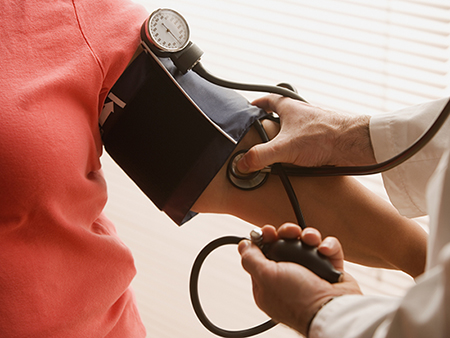 Arm cuff blood pressure measurements may fall short for predicting heart disease risk in some people with resistant high blood pressureA measurement of central blood pressure in people with difficult-to-treat high blood pressure could help reduce risk of heart disease better than traditional arm cuff readings for some patients, according to preliminary research presented at the American Heart Association’s Hypertension 2019 Scientific Sessions.
Arm cuff blood pressure measurements may fall short for predicting heart disease risk in some people with resistant high blood pressureA measurement of central blood pressure in people with difficult-to-treat high blood pressure could help reduce risk of heart disease better than traditional arm cuff readings for some patients, according to preliminary research presented at the American Heart Association’s Hypertension 2019 Scientific Sessions.
Central blood pressure, also called blood pressure amplification, is measured at the aorta, the artery closest to the heart. Researchers found this measurement can more accurately reflect heart disease risk in people with treatment-resistant high blood pressure based on findings from their study.
“We found that higher differences in blood pressure between the arm and the aorta are associated with increased incidence of heart disease in the general population,” said Badhma Valaiyapathi, MBBS, MPH, lead study author and a postdoctoral fellow in vascular biology at the University of Alabama at Birmingham Hypertension Clinic. “We looked specifically at people whose high blood pressure is resistant to treatment, meaning patients’ arm blood pressure readings remain out of control despite the patient’s being on high blood pressure medications.”
The researchers studied adult patients with high blood pressure, including some with difficult-to-treat high blood pressure. Blood pressure and pulse pressure were measured using the traditional arm cuff as well as with pulse wave analysis, to measure central blood pressure when the heart is pumping. Based on the measurements, patients were categorized into three groups: controlled nonresistant blood pressure, controlled resistant blood pressure and uncontrolled resistant blood pressure. Blood pressure amplification was calculated as the difference between the two measures.
The highest blood pressure amplification was found in patients with uncontrolled resistant high blood pressure. The lowest blood pressure amplification was noted among patients who were in the controlled nonresistant category, explaining why risk severity tends to be highest among some adults who have uncontrolled high blood pressure and are resistant to certain medications, according to Valaiyapathi.
“The findings imply that amplification of blood pressure and pulse pressure remains high in patients with resistant hypertension regardless of blood pressure control,” she said. “This means their arteries are stiffer than those of patients with controlled blood pressure, and they’re having problems in their vessels that are leading to heart disease even though they are on medications and even though their blood pressure is under control.”
Valaiyapathi suggested doctors should tailor blood pressure treatment for treatment-resistant high blood pressure patients by taking into consideration central blood pressure, amplification and reinforcing the importance of lifestyle modifications to patients — not only medications — to reduce heart disease risk.
Among the limitations of the study are its small size and that it was performed in the Southern United States. Valaiyapathi says results might not be replicated in the general U.S. population, and that more research in this area was needed.